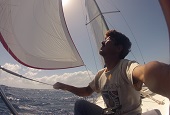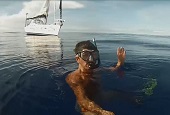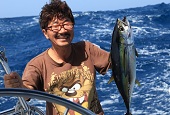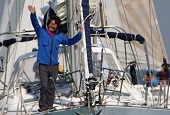



Some 210 days after setting off, skipper Kim Seung-jin completes his around-the-world sailboat trip and returns to Waemokhang Port in Dangjin on May 16.

Kim Seung-jin takes a selfie at the top of the mast.
From the moment he set off, Kim's dream journey wasn't easy. The first crisis came after only 15 days at sea. It was an equipment failure with the mast and sail, making him unable to control the orientation of the sail and the power of the wind. Troubles broke out again and again with the power generator, and many more afterward. Whenever depressed by such difficulties, he thought about the people waiting on terra firma and pulled himself together to fix them all. In the meantime, he succeeded in crossing the equator on November 27, one of the key requirements to completing the solo, non-stop challenge.
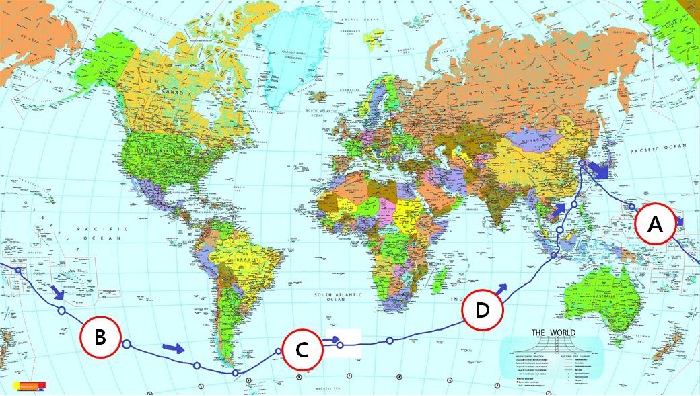

Sailor Kim Seung-jin departed Waemokhang Port in Dangjin on October 18, 2014. He travelled around the world, crossing the Pacific Ocean, the Southern Ocean, the Atlantic Ocean and the Indian Ocean.
As expected before his journey began, Cape Horn was the hardest part of the journey. Located between southern Chile and the Southern Ocean, Cape Horn is known as the, "Everest of the Sea." He was swept and tossed about by large waves, as high as five to seven meters, and by an average wind speed of 36 knots (67 kilometers per hour), with gusts hitting as high as 50 knots (93 kilometers per hour). Such hazardous conditions continued for about five days, with his boat almost capsizing twice and water coming through the ports. Some 107 days after setting out, Kim successfully passed Cape Horn. It was 10:40 p.m. on February 2, 2015.
Kim succeeded in crossing the prime meridian at 11:30 a.m. on February 21, 2015, and passed the Cape of Good Hope in southern Africa at 4:45 p.m. on February 26. By day No. 131, he had travelled 22,970 kilometers and entered the Indian Ocean, over half way done his total journey.

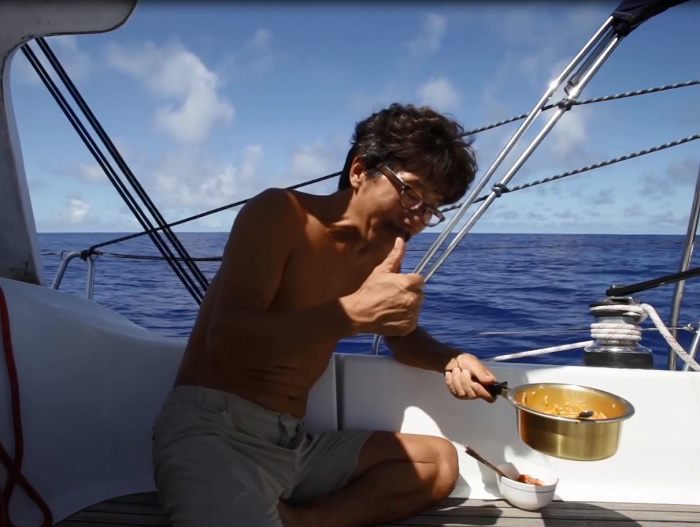
Kim had to find enjoyment in his solitude, handling everything by himself. He cooked bibimbap by himself, rice mixed with baby greens that he had planted and brought onboard, and grilled fish that he caught at sea.
Nothing was predictable and nervousness seemed to continue nonstop. Kim was in danger at some points of being swept along by strong winds and giant waves. At other points, he fell into the doldrums, unable to move. He also worried about the possibility that his boat would be crippled when he encountered some drift ice flowing up from the Southern Ocean.
Early in April, he was pursued by some unidentified vessels when passing through the Sunda Strait between Sumatra and Java, known to be pirate-infested waters. Luckily, he was able to outrun them and soon escaped those waters.
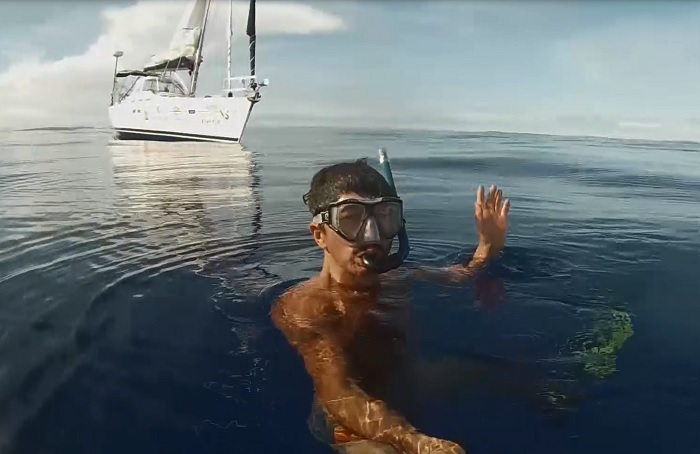
From time to time, Kim enjoyed snorkeling deep into the ocean. It gave him energy to move forward.
On April 7, the Arapani support team approached him near the Sunda Strait with the aid of the Indonesian marine patrol. Kim tossed into the ocean a sealed bag containing some of the videos and photographs that he had shot. Some three hours later after they departed, the team received a satellite phone call from him saying that he had successfully traversed the Sunda Strait.
Kim continued to sail northward to Korea, crossing the equator for the second time at 10:52 p.m. on April 13, 2015. Crossing the equator twice is a key requirement to achieve a world record for a solo, non-stop circumnavigation.
Passing through the East China Sea between Taiwan and mainland China, Kim finally arrived at the west coast of Korea on May 6, with only 1,100 kilometers remaining to his starting point. He passed Pyeongtaekman Bay on May 13 and made a safe return to Waemokhang Port, his original starting point, on May 16. Along with his mother and daughter, some 2,000 people gathered at the port to welcome his safe return. Kim's 210-day challenge finally came to an end.



Sailor Kim Seung-jin thanks all the people who gave him support, at Waemokhang Port on May 16.
By Lee Seung-ah
Photos: Wi Tack-whan, Arapani support team
Korea.net Staff Writers
slee27@korea.kr
Kim Seung-jin's Route
Departed Waemokhang Port on Oct 18, 2014.
Crossed the equator for the first time on Nov 27, 2014.
Passed Fiji in the South Pacific on Dec 17, 2014.
Crossed both the Tropic of Capricorn and the international date line on Dec 21, 2014.
Passed Cape Horn on Feb 2, 2015.
Passed the Cape of Good Hope on Feb 26, 2015.
Traversed the Sunda Strait on Apr 7, 2015.
Crossed the equator for the second time, this time in Southeast Asia, on Apr 13, 2015.
Returned to Waemokhang Port on May 16, 2015.
Most popular
- 2 Egyptian sisters reflect on 10 years as Honorary Reporters
- Actor Bae Doona's first romcom in decade to hit theaters in May
- Korea Welcome Week for foreign tourists set from April 25-May 16
- Korea.net welcomes 2025 K-influencers, Honorary Reporters
- Mini-exhibition brings Korean culture to South London town

